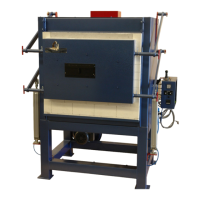
Do you have a question about the FURNACE & ASSAY 168 and is the answer not in the manual?
| Brand | FURNACE & ASSAY |
|---|---|
| Model | 168 |
| Category | Furnace |
| Language | English |
Describes base construction, body, refractory brick, insulation, and adjustment features.
Explains fan forced burner, ignition, fuel swapping, temperature control, and door operation.
Lists electrical requirements, fuel type, gas consumption, pressure, and safety devices.
Details the UV flame detection unit, its checks, and amp meter monitoring.
Lists parts for 12-month replacement, including muffles, tiles, and thermocouples.
Lists essential spare parts like flame detectors, controllers, and ignition components.
Lists additional spare parts such as body, door, regulators, and fittings.
Covers unpacking, manual retrieval, space requirements, and fuel/air supply connections.
Details electrical box connection, plug type, hardwiring, and exhaust ducting checks.
Explains the process of curing a new furnace to strengthen the refractory and manage moisture.
Details slow start-up procedures for furnaces shut down for over 36 hours.
Outlines the warm-up steps for furnaces with a newly installed muffle chamber.
Lists the sequence for turning on the furnace, setting temperature, and burner engagement.
Describes the steps for safely shutting down the furnace, including isolating the gas supply.
Provides detailed gas (LPG) and electrical specifications for the furnace.
Addresses problems related to decreasing/increasing pressure and UV readings.
Details issues with dirty burner equipment and blocked flues, with signs of blockage.
Provides a flowchart for diagnosing power, ignition, and no-flame conditions.
Offers solutions for flames going out at high fire and failure to reach high flame.
Presents a template for weekly checks on pressure, flues, burner gear, and UV cell.
Identifies key components within the furnace's electrical box.
Labels major components of the burner system, including pressure gauge and ignition boot.
Provides a close-up view and labels for burner parts like LPG Jet, Low Fire Orifice, and Air Adjustment.
Details initial gas turn-on, leak checks, pressure verification, and power settings.
Covers ball valve checks, burner control, spark plug, solenoid, temperature settings, and UV cell checks.
Presents the electrical schematic, showing connections between components and their labels.
Illustrates the flow of LPG through valves, filters, and to the burner.
Emphasizes keeping the combustion chamber and rear vent clean for efficiency and longevity.
Discusses cleaning vents, floor tiles, and managing spills to extend muffle life.
Highlights the importance of regular muffle replacement and keeping floor areas clean to prevent overheating.
Advises on cleaning flues, maintaining door blankets, and logging operational data for diagnostics.
Details preparing the chamber by cleaning back/front ledges and burner ports before muffle installation.
Illustrates the steps for removing old components and positioning the new muffle chamber and vent tube.
Describes sealing the muffle/vent with refractory cement and re-installing the thermocouple.
Explains applying mabor powder to the floor for spill absorption and tile protection.
Details placing floor tiles, applying powder on top, and summarizes key maintenance practices.
Details cutting and layering Kaowool for the first three layers of door re-packing.
Describes cutting and fitting the fourth and final Kaowool layers for door re-packing.
Explains how to create anchor holes in the kaowool using a screwdriver and cutter.
Details screwing anchors into place and trimming excess kaowool for a flush finish.
Guides on replacing the inner and outer thermocouple sheaths and connecting the head.
Provides the company's address, phone, fax, email, and website.
